Business Competencies, Functions, and Services at Safeway Supermarket
VerifiedAdded on 2023/06/13
|13
|2075
|232
Report
AI Summary
This report provides a detailed analysis of the business competencies within the Safeway Supermarket chain. It begins with an application landscape diagram illustrating the various components. The report then delves into key business competencies such as contract management (including business management support, budgeting, facility management, and vendor tracking), brand tracking (auditing, pricing administration, and general ledger), and relationship management (market planning, compliance, HR, CRM, PRM, sales programs, and customer acquisition). Furthermore, it explores channel management (correspondence management, advisory services, and customer information profiles), operations (operational planning and tactics, rating, underwriting), and claims (catastrophe planning, claim management, fraud management, and claims processing). The report also outlines group functions like financial accounting (control, budgeting, accounts payable, capital analysis) and vendor management (contract monitoring, service evaluation, cost management), as well as risk management (risk assessment, mitigation, and information security). Finally, it touches on business services, including client support, technical support, quality management, and data quality management. The report concludes with a bibliography of cited sources.
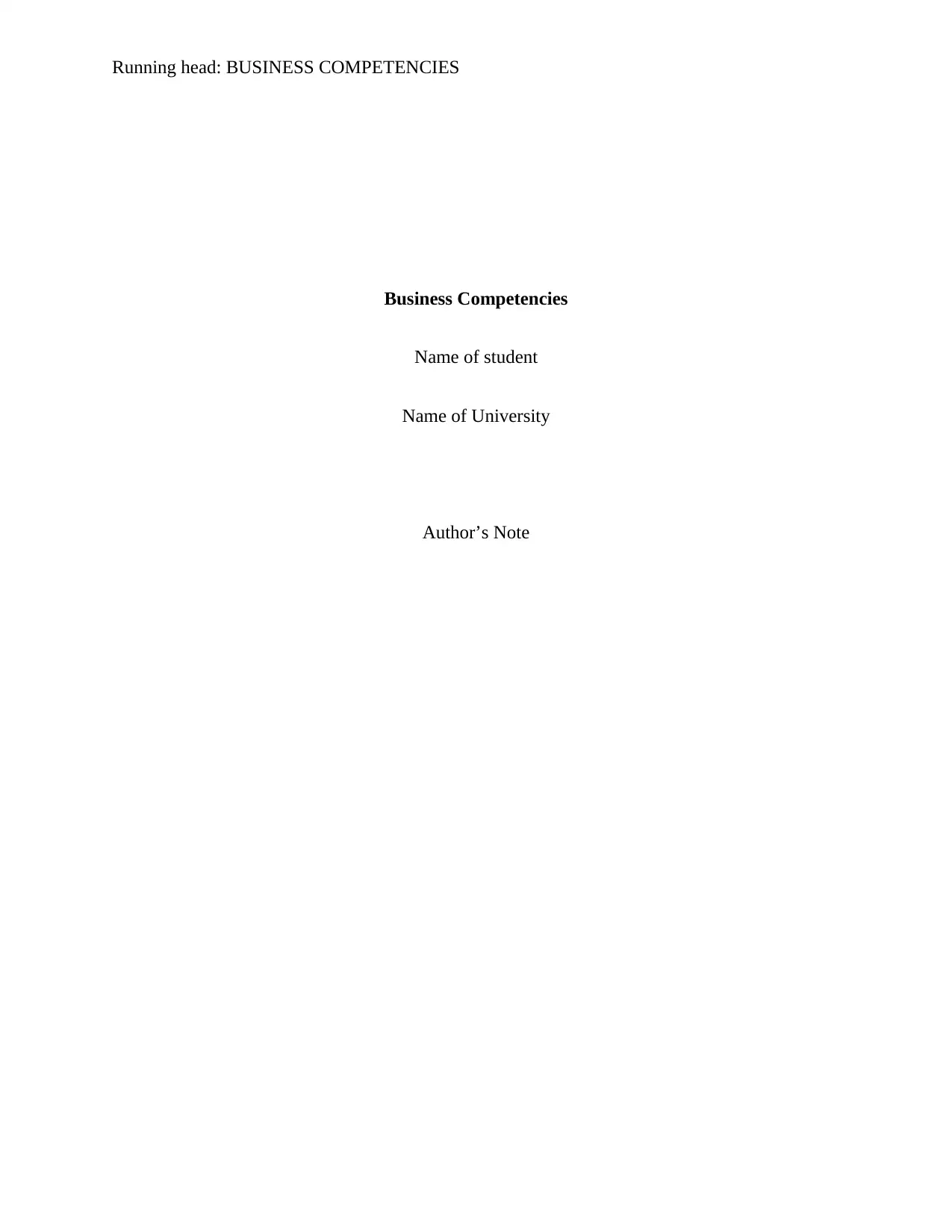
Running head: BUSINESS COMPETENCIES
Business Competencies
Name of student
Name of University
Author’s Note
Business Competencies
Name of student
Name of University
Author’s Note
Paraphrase This Document
Need a fresh take? Get an instant paraphrase of this document with our AI Paraphraser
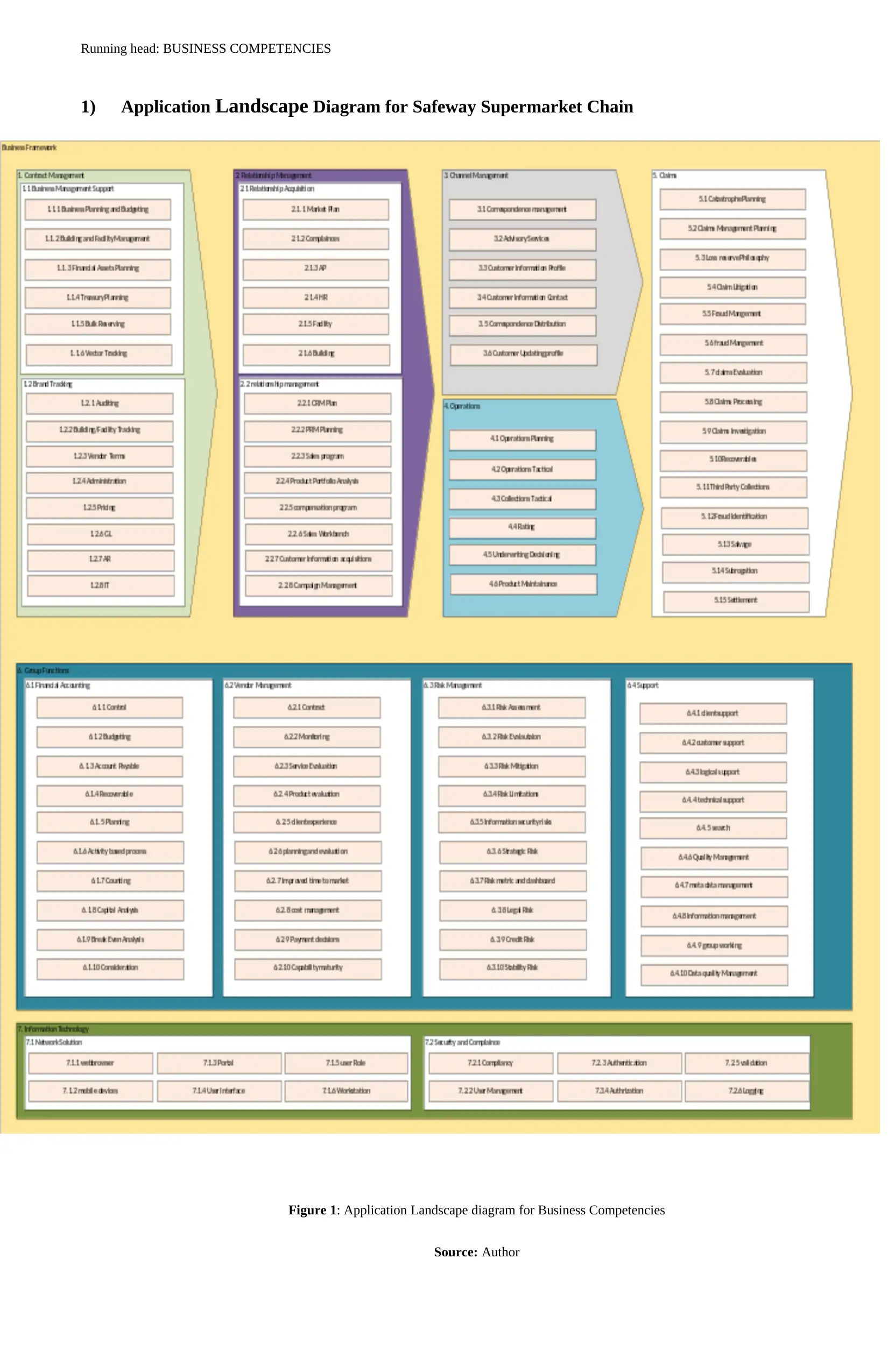
Running head: BUSINESS COMPETENCIES
1) Application Landscape Diagram for Safeway Supermarket Chain
Figure 1: Application Landscape diagram for Business Competencies
Source: Author
1) Application Landscape Diagram for Safeway Supermarket Chain
Figure 1: Application Landscape diagram for Business Competencies
Source: Author
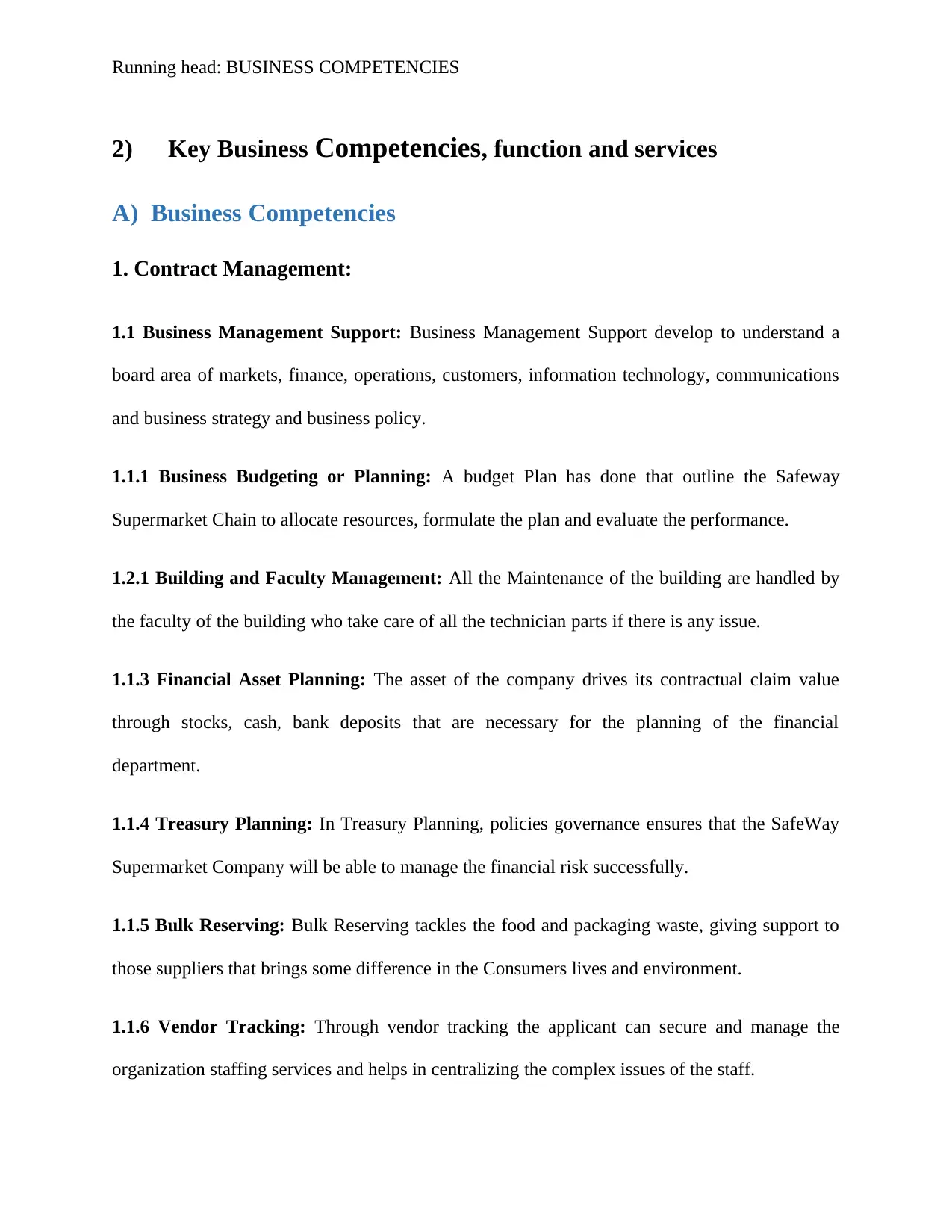
Running head: BUSINESS COMPETENCIES
2) Key Business Competencies, function and services
A) Business Competencies
1. Contract Management:
1.1 Business Management Support: Business Management Support develop to understand a
board area of markets, finance, operations, customers, information technology, communications
and business strategy and business policy.
1.1.1 Business Budgeting or Planning: A budget Plan has done that outline the Safeway
Supermarket Chain to allocate resources, formulate the plan and evaluate the performance.
1.2.1 Building and Faculty Management: All the Maintenance of the building are handled by
the faculty of the building who take care of all the technician parts if there is any issue.
1.1.3 Financial Asset Planning: The asset of the company drives its contractual claim value
through stocks, cash, bank deposits that are necessary for the planning of the financial
department.
1.1.4 Treasury Planning: In Treasury Planning, policies governance ensures that the SafeWay
Supermarket Company will be able to manage the financial risk successfully.
1.1.5 Bulk Reserving: Bulk Reserving tackles the food and packaging waste, giving support to
those suppliers that brings some difference in the Consumers lives and environment.
1.1.6 Vendor Tracking: Through vendor tracking the applicant can secure and manage the
organization staffing services and helps in centralizing the complex issues of the staff.
2) Key Business Competencies, function and services
A) Business Competencies
1. Contract Management:
1.1 Business Management Support: Business Management Support develop to understand a
board area of markets, finance, operations, customers, information technology, communications
and business strategy and business policy.
1.1.1 Business Budgeting or Planning: A budget Plan has done that outline the Safeway
Supermarket Chain to allocate resources, formulate the plan and evaluate the performance.
1.2.1 Building and Faculty Management: All the Maintenance of the building are handled by
the faculty of the building who take care of all the technician parts if there is any issue.
1.1.3 Financial Asset Planning: The asset of the company drives its contractual claim value
through stocks, cash, bank deposits that are necessary for the planning of the financial
department.
1.1.4 Treasury Planning: In Treasury Planning, policies governance ensures that the SafeWay
Supermarket Company will be able to manage the financial risk successfully.
1.1.5 Bulk Reserving: Bulk Reserving tackles the food and packaging waste, giving support to
those suppliers that brings some difference in the Consumers lives and environment.
1.1.6 Vendor Tracking: Through vendor tracking the applicant can secure and manage the
organization staffing services and helps in centralizing the complex issues of the staff.
⊘ This is a preview!⊘
Do you want full access?
Subscribe today to unlock all pages.

Trusted by 1+ million students worldwide
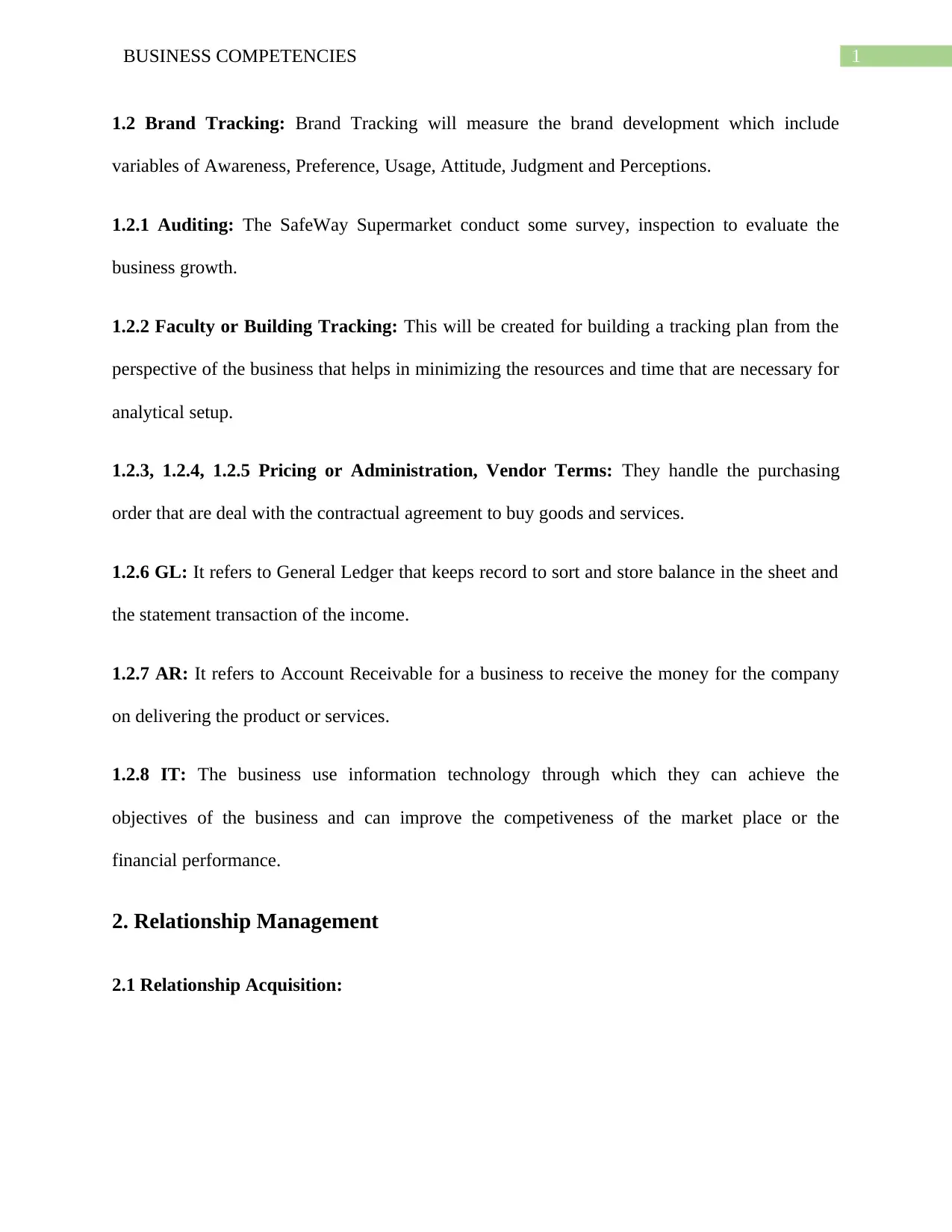
1BUSINESS COMPETENCIES
1.2 Brand Tracking: Brand Tracking will measure the brand development which include
variables of Awareness, Preference, Usage, Attitude, Judgment and Perceptions.
1.2.1 Auditing: The SafeWay Supermarket conduct some survey, inspection to evaluate the
business growth.
1.2.2 Faculty or Building Tracking: This will be created for building a tracking plan from the
perspective of the business that helps in minimizing the resources and time that are necessary for
analytical setup.
1.2.3, 1.2.4, 1.2.5 Pricing or Administration, Vendor Terms: They handle the purchasing
order that are deal with the contractual agreement to buy goods and services.
1.2.6 GL: It refers to General Ledger that keeps record to sort and store balance in the sheet and
the statement transaction of the income.
1.2.7 AR: It refers to Account Receivable for a business to receive the money for the company
on delivering the product or services.
1.2.8 IT: The business use information technology through which they can achieve the
objectives of the business and can improve the competiveness of the market place or the
financial performance.
2. Relationship Management
2.1 Relationship Acquisition:
1.2 Brand Tracking: Brand Tracking will measure the brand development which include
variables of Awareness, Preference, Usage, Attitude, Judgment and Perceptions.
1.2.1 Auditing: The SafeWay Supermarket conduct some survey, inspection to evaluate the
business growth.
1.2.2 Faculty or Building Tracking: This will be created for building a tracking plan from the
perspective of the business that helps in minimizing the resources and time that are necessary for
analytical setup.
1.2.3, 1.2.4, 1.2.5 Pricing or Administration, Vendor Terms: They handle the purchasing
order that are deal with the contractual agreement to buy goods and services.
1.2.6 GL: It refers to General Ledger that keeps record to sort and store balance in the sheet and
the statement transaction of the income.
1.2.7 AR: It refers to Account Receivable for a business to receive the money for the company
on delivering the product or services.
1.2.8 IT: The business use information technology through which they can achieve the
objectives of the business and can improve the competiveness of the market place or the
financial performance.
2. Relationship Management
2.1 Relationship Acquisition:
Paraphrase This Document
Need a fresh take? Get an instant paraphrase of this document with our AI Paraphraser
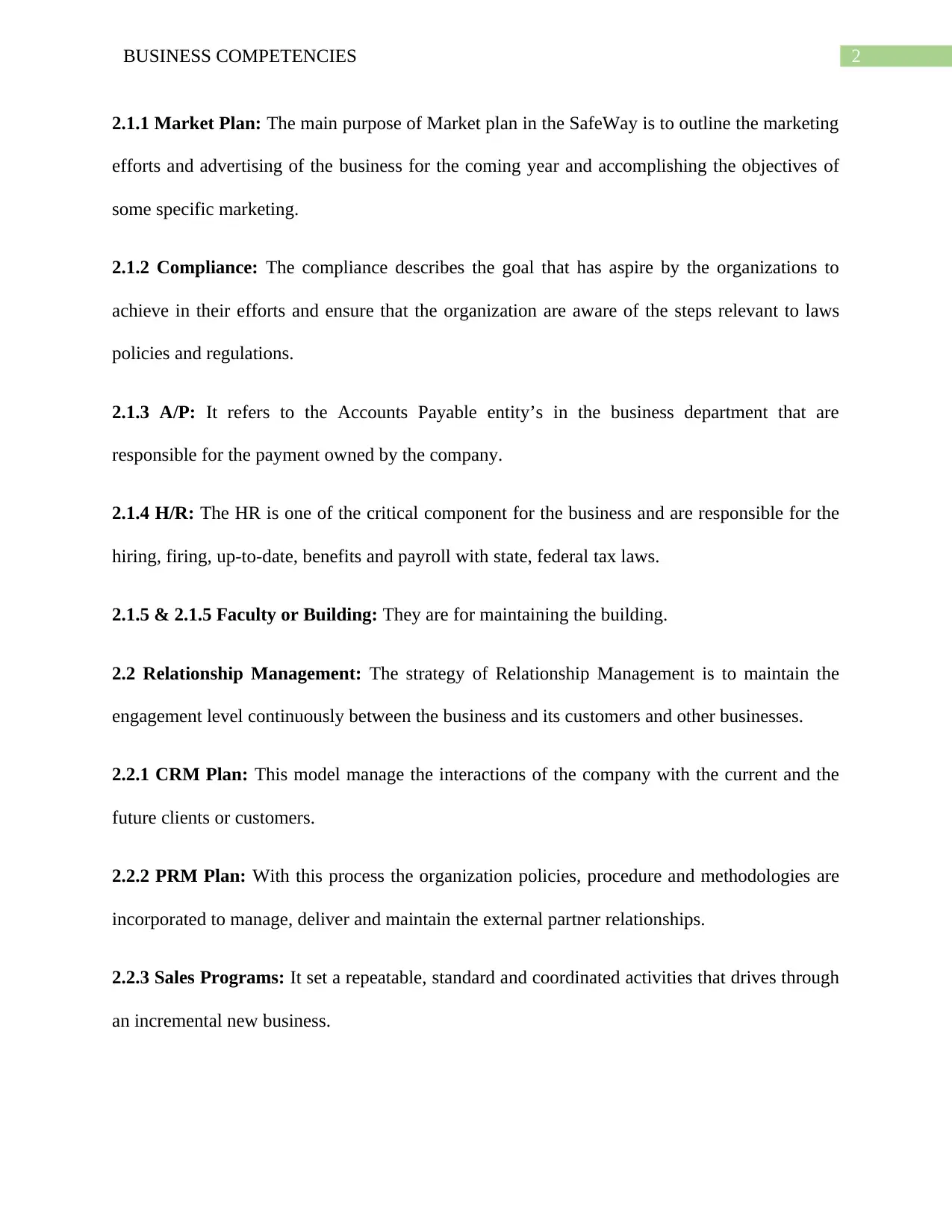
2BUSINESS COMPETENCIES
2.1.1 Market Plan: The main purpose of Market plan in the SafeWay is to outline the marketing
efforts and advertising of the business for the coming year and accomplishing the objectives of
some specific marketing.
2.1.2 Compliance: The compliance describes the goal that has aspire by the organizations to
achieve in their efforts and ensure that the organization are aware of the steps relevant to laws
policies and regulations.
2.1.3 A/P: It refers to the Accounts Payable entity’s in the business department that are
responsible for the payment owned by the company.
2.1.4 H/R: The HR is one of the critical component for the business and are responsible for the
hiring, firing, up-to-date, benefits and payroll with state, federal tax laws.
2.1.5 & 2.1.5 Faculty or Building: They are for maintaining the building.
2.2 Relationship Management: The strategy of Relationship Management is to maintain the
engagement level continuously between the business and its customers and other businesses.
2.2.1 CRM Plan: This model manage the interactions of the company with the current and the
future clients or customers.
2.2.2 PRM Plan: With this process the organization policies, procedure and methodologies are
incorporated to manage, deliver and maintain the external partner relationships.
2.2.3 Sales Programs: It set a repeatable, standard and coordinated activities that drives through
an incremental new business.
2.1.1 Market Plan: The main purpose of Market plan in the SafeWay is to outline the marketing
efforts and advertising of the business for the coming year and accomplishing the objectives of
some specific marketing.
2.1.2 Compliance: The compliance describes the goal that has aspire by the organizations to
achieve in their efforts and ensure that the organization are aware of the steps relevant to laws
policies and regulations.
2.1.3 A/P: It refers to the Accounts Payable entity’s in the business department that are
responsible for the payment owned by the company.
2.1.4 H/R: The HR is one of the critical component for the business and are responsible for the
hiring, firing, up-to-date, benefits and payroll with state, federal tax laws.
2.1.5 & 2.1.5 Faculty or Building: They are for maintaining the building.
2.2 Relationship Management: The strategy of Relationship Management is to maintain the
engagement level continuously between the business and its customers and other businesses.
2.2.1 CRM Plan: This model manage the interactions of the company with the current and the
future clients or customers.
2.2.2 PRM Plan: With this process the organization policies, procedure and methodologies are
incorporated to manage, deliver and maintain the external partner relationships.
2.2.3 Sales Programs: It set a repeatable, standard and coordinated activities that drives through
an incremental new business.
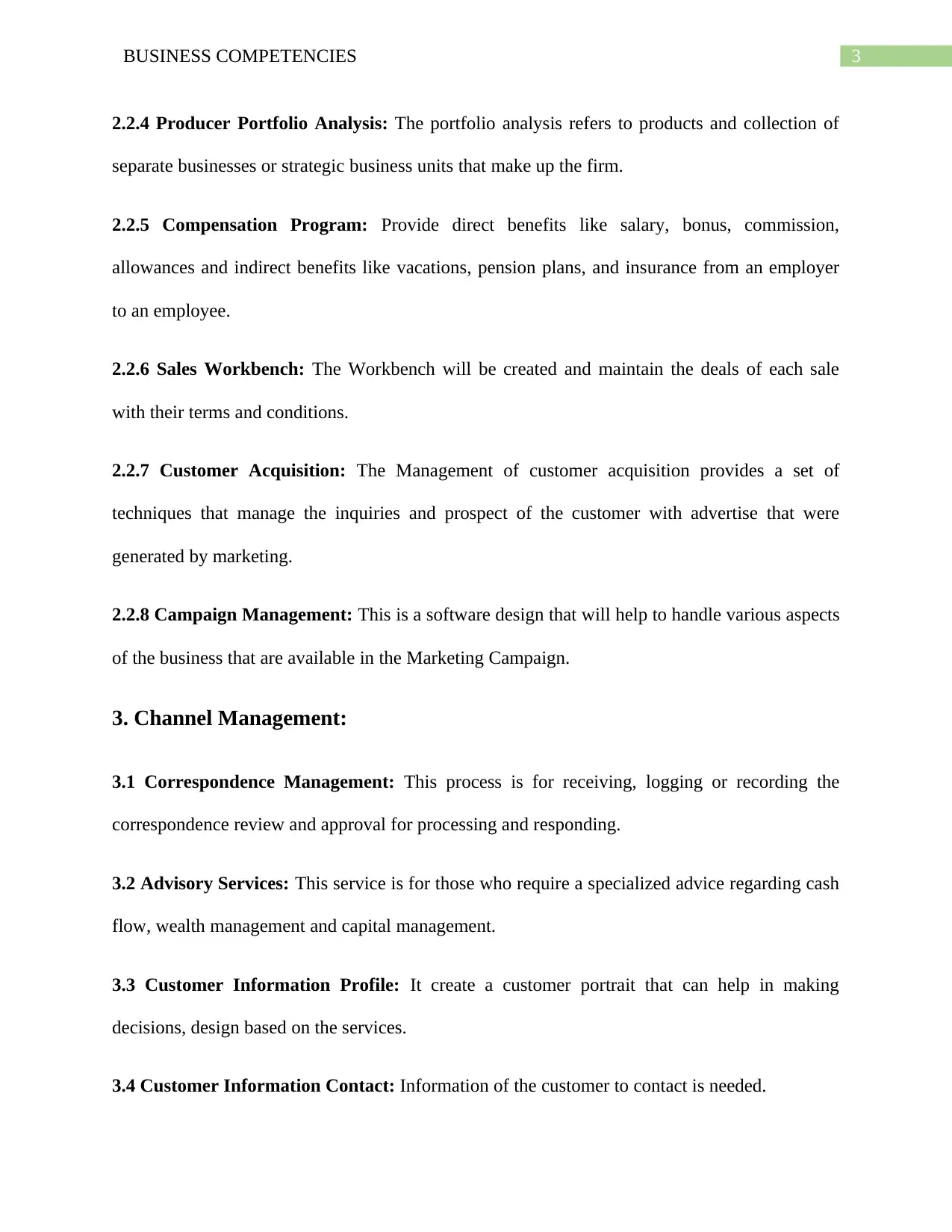
3BUSINESS COMPETENCIES
2.2.4 Producer Portfolio Analysis: The portfolio analysis refers to products and collection of
separate businesses or strategic business units that make up the firm.
2.2.5 Compensation Program: Provide direct benefits like salary, bonus, commission,
allowances and indirect benefits like vacations, pension plans, and insurance from an employer
to an employee.
2.2.6 Sales Workbench: The Workbench will be created and maintain the deals of each sale
with their terms and conditions.
2.2.7 Customer Acquisition: The Management of customer acquisition provides a set of
techniques that manage the inquiries and prospect of the customer with advertise that were
generated by marketing.
2.2.8 Campaign Management: This is a software design that will help to handle various aspects
of the business that are available in the Marketing Campaign.
3. Channel Management:
3.1 Correspondence Management: This process is for receiving, logging or recording the
correspondence review and approval for processing and responding.
3.2 Advisory Services: This service is for those who require a specialized advice regarding cash
flow, wealth management and capital management.
3.3 Customer Information Profile: It create a customer portrait that can help in making
decisions, design based on the services.
3.4 Customer Information Contact: Information of the customer to contact is needed.
2.2.4 Producer Portfolio Analysis: The portfolio analysis refers to products and collection of
separate businesses or strategic business units that make up the firm.
2.2.5 Compensation Program: Provide direct benefits like salary, bonus, commission,
allowances and indirect benefits like vacations, pension plans, and insurance from an employer
to an employee.
2.2.6 Sales Workbench: The Workbench will be created and maintain the deals of each sale
with their terms and conditions.
2.2.7 Customer Acquisition: The Management of customer acquisition provides a set of
techniques that manage the inquiries and prospect of the customer with advertise that were
generated by marketing.
2.2.8 Campaign Management: This is a software design that will help to handle various aspects
of the business that are available in the Marketing Campaign.
3. Channel Management:
3.1 Correspondence Management: This process is for receiving, logging or recording the
correspondence review and approval for processing and responding.
3.2 Advisory Services: This service is for those who require a specialized advice regarding cash
flow, wealth management and capital management.
3.3 Customer Information Profile: It create a customer portrait that can help in making
decisions, design based on the services.
3.4 Customer Information Contact: Information of the customer to contact is needed.
⊘ This is a preview!⊘
Do you want full access?
Subscribe today to unlock all pages.

Trusted by 1+ million students worldwide
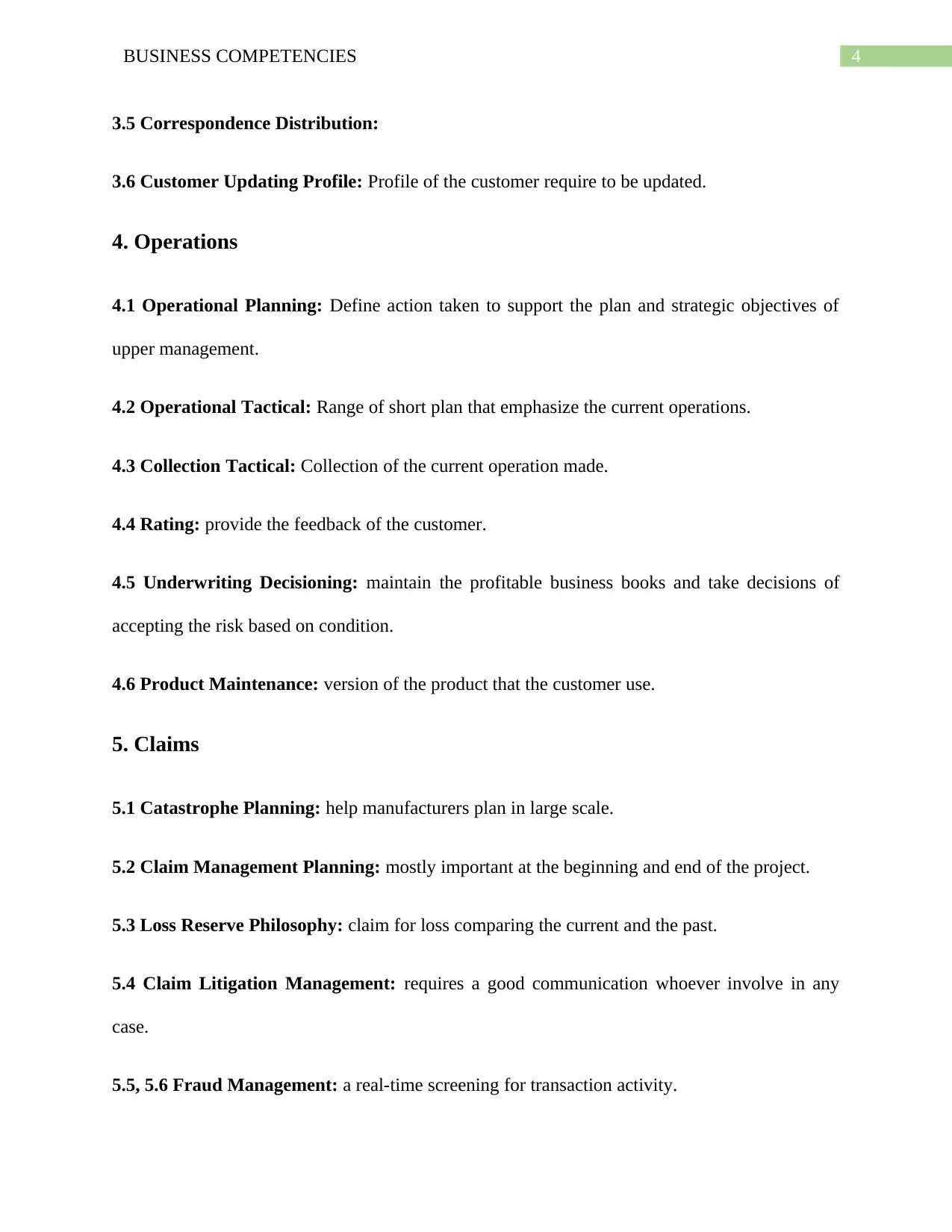
4BUSINESS COMPETENCIES
3.5 Correspondence Distribution:
3.6 Customer Updating Profile: Profile of the customer require to be updated.
4. Operations
4.1 Operational Planning: Define action taken to support the plan and strategic objectives of
upper management.
4.2 Operational Tactical: Range of short plan that emphasize the current operations.
4.3 Collection Tactical: Collection of the current operation made.
4.4 Rating: provide the feedback of the customer.
4.5 Underwriting Decisioning: maintain the profitable business books and take decisions of
accepting the risk based on condition.
4.6 Product Maintenance: version of the product that the customer use.
5. Claims
5.1 Catastrophe Planning: help manufacturers plan in large scale.
5.2 Claim Management Planning: mostly important at the beginning and end of the project.
5.3 Loss Reserve Philosophy: claim for loss comparing the current and the past.
5.4 Claim Litigation Management: requires a good communication whoever involve in any
case.
5.5, 5.6 Fraud Management: a real-time screening for transaction activity.
3.5 Correspondence Distribution:
3.6 Customer Updating Profile: Profile of the customer require to be updated.
4. Operations
4.1 Operational Planning: Define action taken to support the plan and strategic objectives of
upper management.
4.2 Operational Tactical: Range of short plan that emphasize the current operations.
4.3 Collection Tactical: Collection of the current operation made.
4.4 Rating: provide the feedback of the customer.
4.5 Underwriting Decisioning: maintain the profitable business books and take decisions of
accepting the risk based on condition.
4.6 Product Maintenance: version of the product that the customer use.
5. Claims
5.1 Catastrophe Planning: help manufacturers plan in large scale.
5.2 Claim Management Planning: mostly important at the beginning and end of the project.
5.3 Loss Reserve Philosophy: claim for loss comparing the current and the past.
5.4 Claim Litigation Management: requires a good communication whoever involve in any
case.
5.5, 5.6 Fraud Management: a real-time screening for transaction activity.
Paraphrase This Document
Need a fresh take? Get an instant paraphrase of this document with our AI Paraphraser
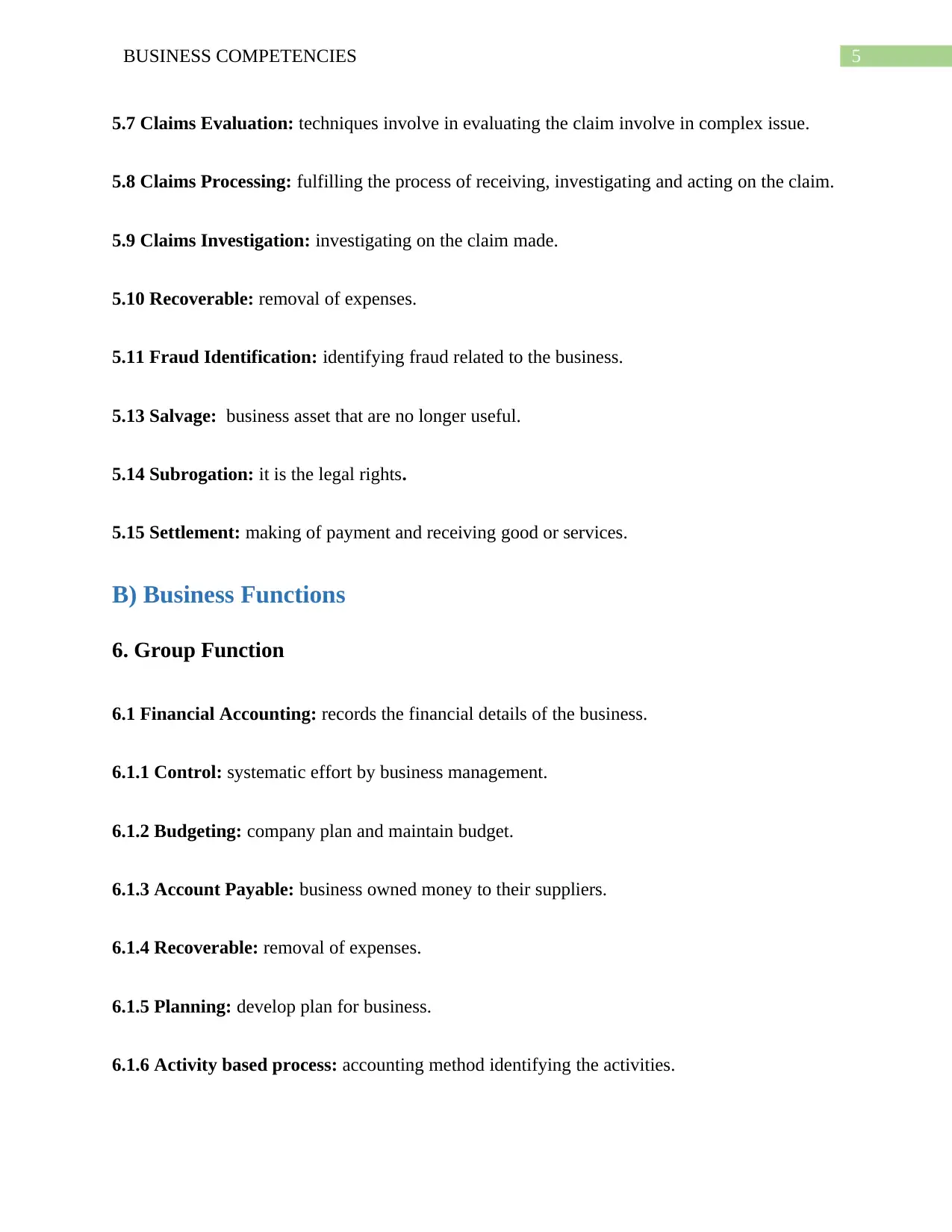
5BUSINESS COMPETENCIES
5.7 Claims Evaluation: techniques involve in evaluating the claim involve in complex issue.
5.8 Claims Processing: fulfilling the process of receiving, investigating and acting on the claim.
5.9 Claims Investigation: investigating on the claim made.
5.10 Recoverable: removal of expenses.
5.11 Fraud Identification: identifying fraud related to the business.
5.13 Salvage: business asset that are no longer useful.
5.14 Subrogation: it is the legal rights.
5.15 Settlement: making of payment and receiving good or services.
B) Business Functions
6. Group Function
6.1 Financial Accounting: records the financial details of the business.
6.1.1 Control: systematic effort by business management.
6.1.2 Budgeting: company plan and maintain budget.
6.1.3 Account Payable: business owned money to their suppliers.
6.1.4 Recoverable: removal of expenses.
6.1.5 Planning: develop plan for business.
6.1.6 Activity based process: accounting method identifying the activities.
5.7 Claims Evaluation: techniques involve in evaluating the claim involve in complex issue.
5.8 Claims Processing: fulfilling the process of receiving, investigating and acting on the claim.
5.9 Claims Investigation: investigating on the claim made.
5.10 Recoverable: removal of expenses.
5.11 Fraud Identification: identifying fraud related to the business.
5.13 Salvage: business asset that are no longer useful.
5.14 Subrogation: it is the legal rights.
5.15 Settlement: making of payment and receiving good or services.
B) Business Functions
6. Group Function
6.1 Financial Accounting: records the financial details of the business.
6.1.1 Control: systematic effort by business management.
6.1.2 Budgeting: company plan and maintain budget.
6.1.3 Account Payable: business owned money to their suppliers.
6.1.4 Recoverable: removal of expenses.
6.1.5 Planning: develop plan for business.
6.1.6 Activity based process: accounting method identifying the activities.
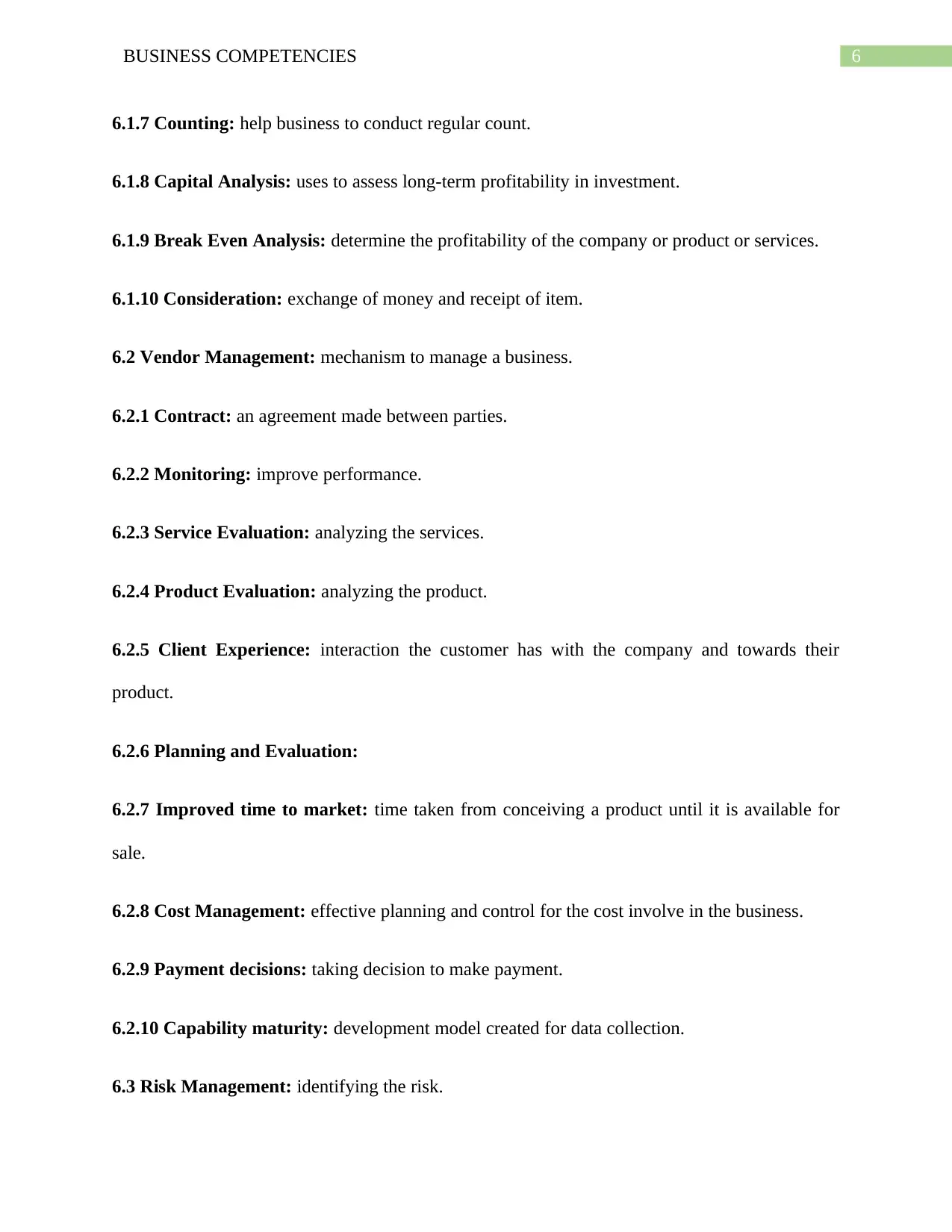
6BUSINESS COMPETENCIES
6.1.7 Counting: help business to conduct regular count.
6.1.8 Capital Analysis: uses to assess long-term profitability in investment.
6.1.9 Break Even Analysis: determine the profitability of the company or product or services.
6.1.10 Consideration: exchange of money and receipt of item.
6.2 Vendor Management: mechanism to manage a business.
6.2.1 Contract: an agreement made between parties.
6.2.2 Monitoring: improve performance.
6.2.3 Service Evaluation: analyzing the services.
6.2.4 Product Evaluation: analyzing the product.
6.2.5 Client Experience: interaction the customer has with the company and towards their
product.
6.2.6 Planning and Evaluation:
6.2.7 Improved time to market: time taken from conceiving a product until it is available for
sale.
6.2.8 Cost Management: effective planning and control for the cost involve in the business.
6.2.9 Payment decisions: taking decision to make payment.
6.2.10 Capability maturity: development model created for data collection.
6.3 Risk Management: identifying the risk.
6.1.7 Counting: help business to conduct regular count.
6.1.8 Capital Analysis: uses to assess long-term profitability in investment.
6.1.9 Break Even Analysis: determine the profitability of the company or product or services.
6.1.10 Consideration: exchange of money and receipt of item.
6.2 Vendor Management: mechanism to manage a business.
6.2.1 Contract: an agreement made between parties.
6.2.2 Monitoring: improve performance.
6.2.3 Service Evaluation: analyzing the services.
6.2.4 Product Evaluation: analyzing the product.
6.2.5 Client Experience: interaction the customer has with the company and towards their
product.
6.2.6 Planning and Evaluation:
6.2.7 Improved time to market: time taken from conceiving a product until it is available for
sale.
6.2.8 Cost Management: effective planning and control for the cost involve in the business.
6.2.9 Payment decisions: taking decision to make payment.
6.2.10 Capability maturity: development model created for data collection.
6.3 Risk Management: identifying the risk.
⊘ This is a preview!⊘
Do you want full access?
Subscribe today to unlock all pages.

Trusted by 1+ million students worldwide
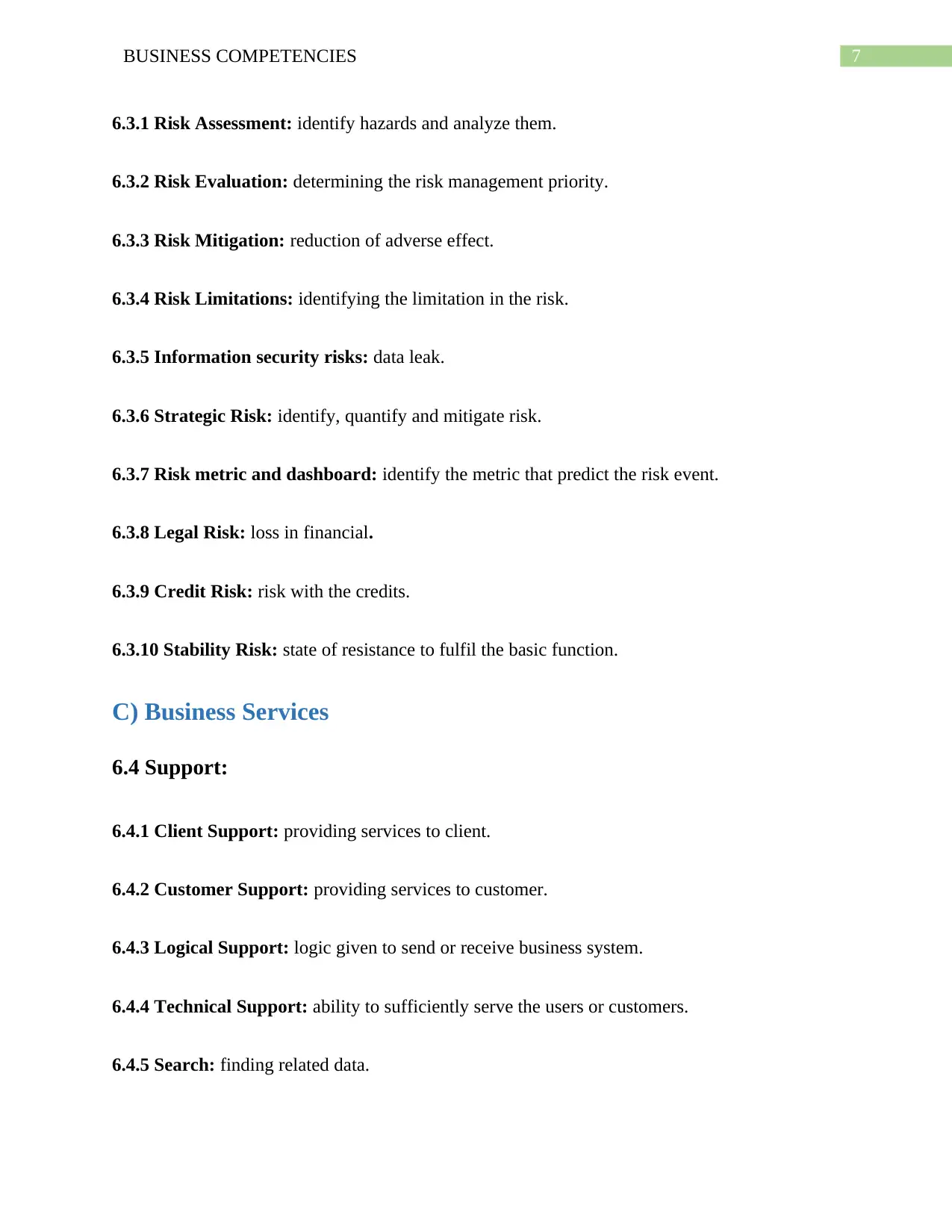
7BUSINESS COMPETENCIES
6.3.1 Risk Assessment: identify hazards and analyze them.
6.3.2 Risk Evaluation: determining the risk management priority.
6.3.3 Risk Mitigation: reduction of adverse effect.
6.3.4 Risk Limitations: identifying the limitation in the risk.
6.3.5 Information security risks: data leak.
6.3.6 Strategic Risk: identify, quantify and mitigate risk.
6.3.7 Risk metric and dashboard: identify the metric that predict the risk event.
6.3.8 Legal Risk: loss in financial.
6.3.9 Credit Risk: risk with the credits.
6.3.10 Stability Risk: state of resistance to fulfil the basic function.
C) Business Services
6.4 Support:
6.4.1 Client Support: providing services to client.
6.4.2 Customer Support: providing services to customer.
6.4.3 Logical Support: logic given to send or receive business system.
6.4.4 Technical Support: ability to sufficiently serve the users or customers.
6.4.5 Search: finding related data.
6.3.1 Risk Assessment: identify hazards and analyze them.
6.3.2 Risk Evaluation: determining the risk management priority.
6.3.3 Risk Mitigation: reduction of adverse effect.
6.3.4 Risk Limitations: identifying the limitation in the risk.
6.3.5 Information security risks: data leak.
6.3.6 Strategic Risk: identify, quantify and mitigate risk.
6.3.7 Risk metric and dashboard: identify the metric that predict the risk event.
6.3.8 Legal Risk: loss in financial.
6.3.9 Credit Risk: risk with the credits.
6.3.10 Stability Risk: state of resistance to fulfil the basic function.
C) Business Services
6.4 Support:
6.4.1 Client Support: providing services to client.
6.4.2 Customer Support: providing services to customer.
6.4.3 Logical Support: logic given to send or receive business system.
6.4.4 Technical Support: ability to sufficiently serve the users or customers.
6.4.5 Search: finding related data.
Paraphrase This Document
Need a fresh take? Get an instant paraphrase of this document with our AI Paraphraser
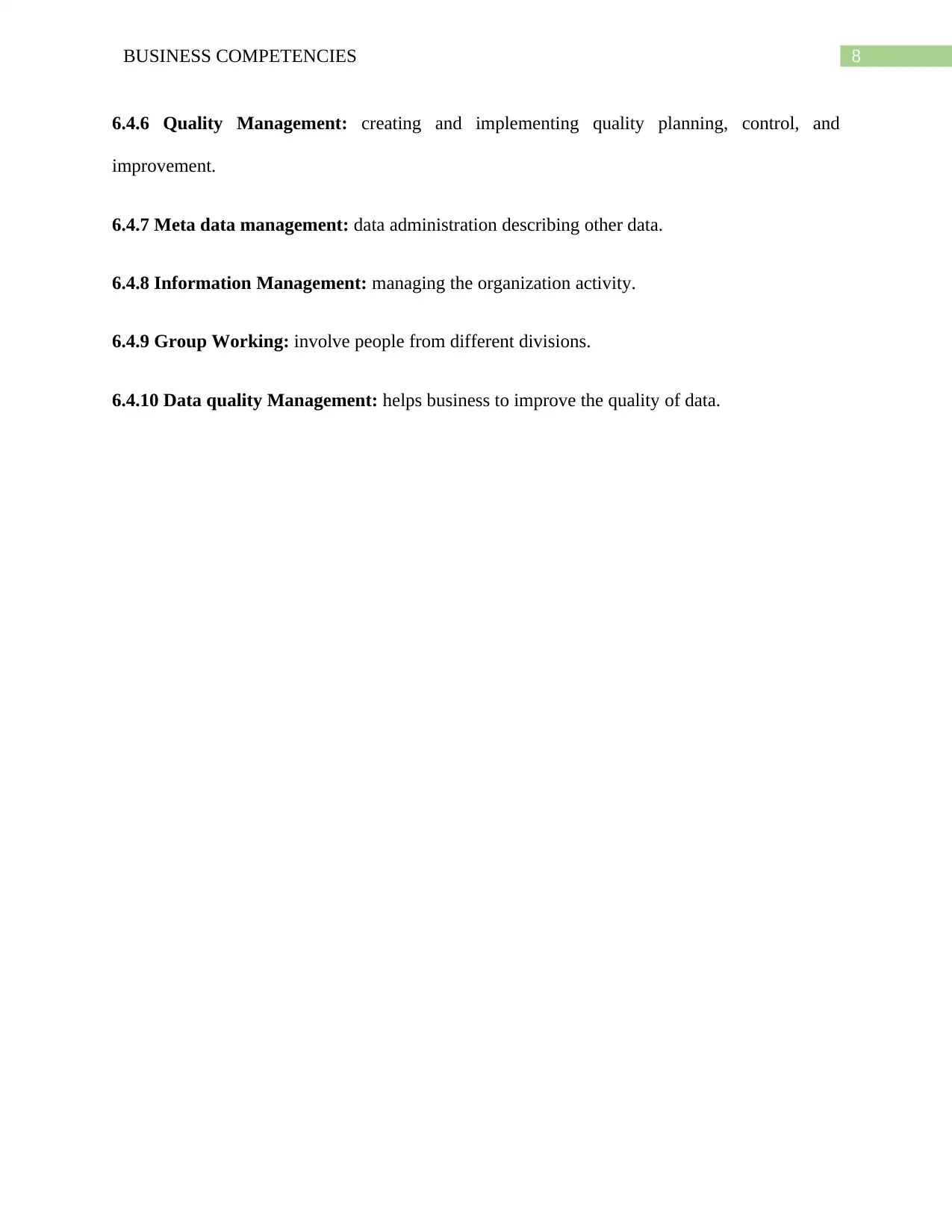
8BUSINESS COMPETENCIES
6.4.6 Quality Management: creating and implementing quality planning, control, and
improvement.
6.4.7 Meta data management: data administration describing other data.
6.4.8 Information Management: managing the organization activity.
6.4.9 Group Working: involve people from different divisions.
6.4.10 Data quality Management: helps business to improve the quality of data.
6.4.6 Quality Management: creating and implementing quality planning, control, and
improvement.
6.4.7 Meta data management: data administration describing other data.
6.4.8 Information Management: managing the organization activity.
6.4.9 Group Working: involve people from different divisions.
6.4.10 Data quality Management: helps business to improve the quality of data.
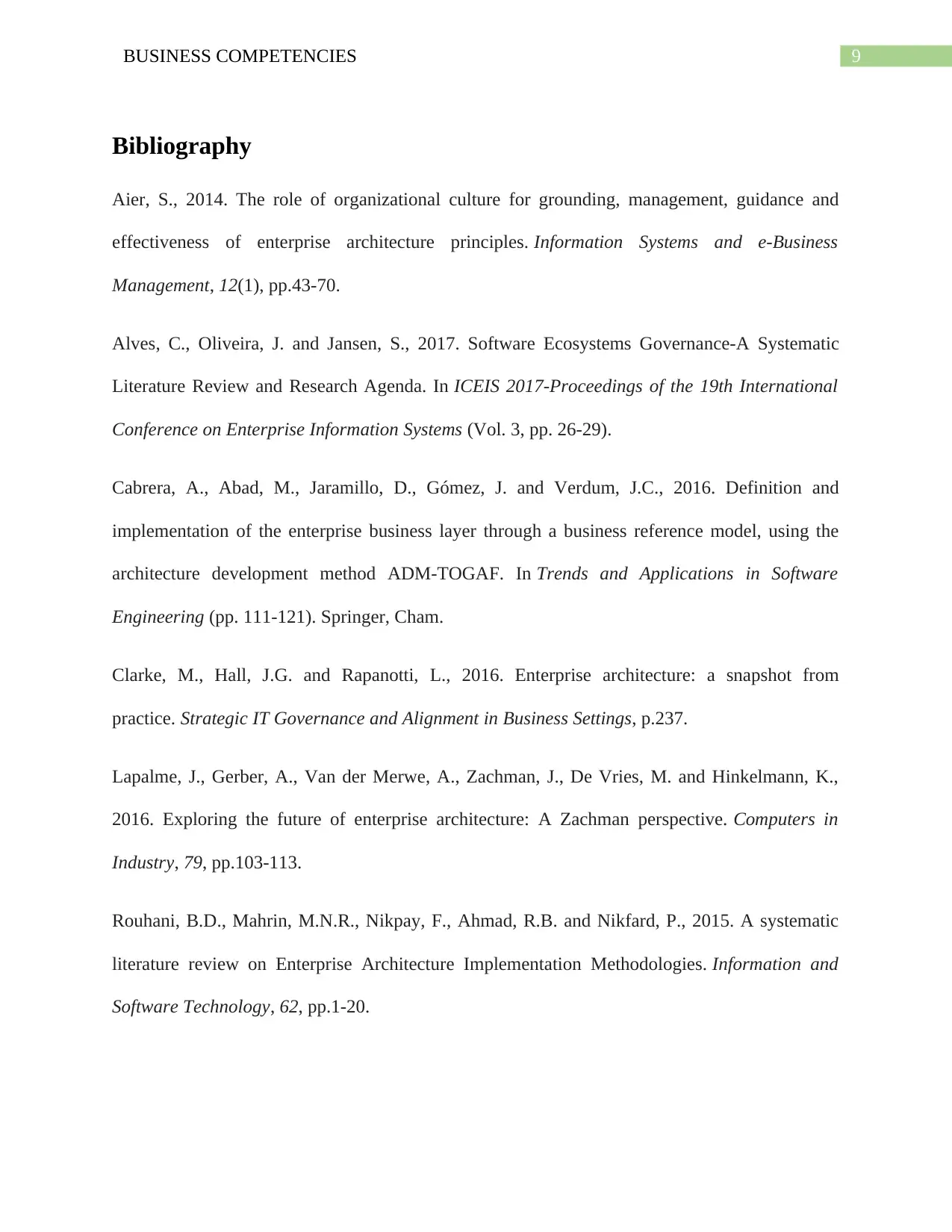
9BUSINESS COMPETENCIES
Bibliography
Aier, S., 2014. The role of organizational culture for grounding, management, guidance and
effectiveness of enterprise architecture principles. Information Systems and e-Business
Management, 12(1), pp.43-70.
Alves, C., Oliveira, J. and Jansen, S., 2017. Software Ecosystems Governance-A Systematic
Literature Review and Research Agenda. In ICEIS 2017-Proceedings of the 19th International
Conference on Enterprise Information Systems (Vol. 3, pp. 26-29).
Cabrera, A., Abad, M., Jaramillo, D., Gómez, J. and Verdum, J.C., 2016. Definition and
implementation of the enterprise business layer through a business reference model, using the
architecture development method ADM-TOGAF. In Trends and Applications in Software
Engineering (pp. 111-121). Springer, Cham.
Clarke, M., Hall, J.G. and Rapanotti, L., 2016. Enterprise architecture: a snapshot from
practice. Strategic IT Governance and Alignment in Business Settings, p.237.
Lapalme, J., Gerber, A., Van der Merwe, A., Zachman, J., De Vries, M. and Hinkelmann, K.,
2016. Exploring the future of enterprise architecture: A Zachman perspective. Computers in
Industry, 79, pp.103-113.
Rouhani, B.D., Mahrin, M.N.R., Nikpay, F., Ahmad, R.B. and Nikfard, P., 2015. A systematic
literature review on Enterprise Architecture Implementation Methodologies. Information and
Software Technology, 62, pp.1-20.
Bibliography
Aier, S., 2014. The role of organizational culture for grounding, management, guidance and
effectiveness of enterprise architecture principles. Information Systems and e-Business
Management, 12(1), pp.43-70.
Alves, C., Oliveira, J. and Jansen, S., 2017. Software Ecosystems Governance-A Systematic
Literature Review and Research Agenda. In ICEIS 2017-Proceedings of the 19th International
Conference on Enterprise Information Systems (Vol. 3, pp. 26-29).
Cabrera, A., Abad, M., Jaramillo, D., Gómez, J. and Verdum, J.C., 2016. Definition and
implementation of the enterprise business layer through a business reference model, using the
architecture development method ADM-TOGAF. In Trends and Applications in Software
Engineering (pp. 111-121). Springer, Cham.
Clarke, M., Hall, J.G. and Rapanotti, L., 2016. Enterprise architecture: a snapshot from
practice. Strategic IT Governance and Alignment in Business Settings, p.237.
Lapalme, J., Gerber, A., Van der Merwe, A., Zachman, J., De Vries, M. and Hinkelmann, K.,
2016. Exploring the future of enterprise architecture: A Zachman perspective. Computers in
Industry, 79, pp.103-113.
Rouhani, B.D., Mahrin, M.N.R., Nikpay, F., Ahmad, R.B. and Nikfard, P., 2015. A systematic
literature review on Enterprise Architecture Implementation Methodologies. Information and
Software Technology, 62, pp.1-20.
⊘ This is a preview!⊘
Do you want full access?
Subscribe today to unlock all pages.

Trusted by 1+ million students worldwide
1 out of 13
Your All-in-One AI-Powered Toolkit for Academic Success.
+13062052269
info@desklib.com
Available 24*7 on WhatsApp / Email
![[object Object]](/_next/static/media/star-bottom.7253800d.svg)
Unlock your academic potential
Copyright © 2020–2025 A2Z Services. All Rights Reserved. Developed and managed by ZUCOL.

